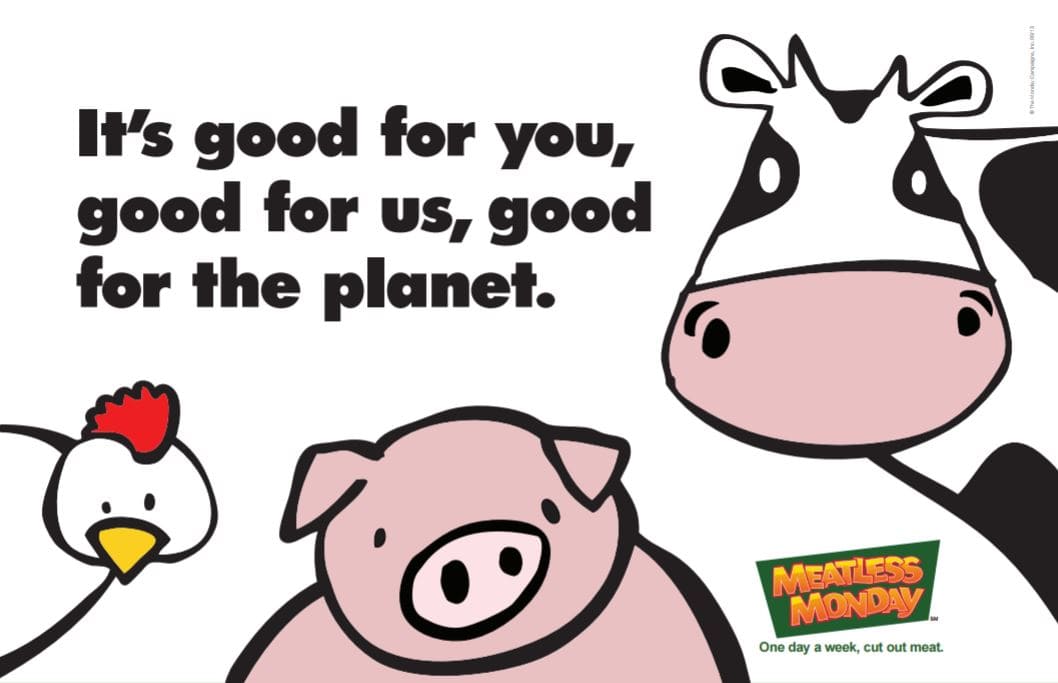One day a week, cut out meat is a way for individuals to do something good for themselves and for the planet. Sid Lerner, Founder & Chairman of Meatless Mondays in association with Johns Hopkins University
Why Meatless?
Because going meatless once a week may reduce your risk of chronic preventable conditions like cancer, cardiovascular disease, diabetes, and obesity. And going meatless once a week can also help reduce our carbon footprint and save precious resources like fossil fuels and fresh water.

It may come as a surprise to learn that livestock production is a major contributor to global emissions of greenhouse gasses. In fact, 53 percent of nitrous oxide emissions and around 14,5 percent of global greenhouse gas (GHG) emission totals can be traced to the meat and dairy industry – this is roughly equivalent to the amount of GHG’s emitted from tailpipes of cars and trucks across the globe.
These staggeringly high emissions from livestock production are a result of a variety of factors. For example, more resources are required to produce livestock than any other crops. Higher amounts of feed, land, and shelter are needed to produce one pound of meat than one pound of grain. This is because animals require high amounts of feed in order to grow to sizes where they can be sent to market. Livestock also constantly emit gasses through the creation of manure – releasing high amounts of methane into the atmosphere.
Recently, China has sought to reduce meat consumption by writing diet guidelines where meat products take up a smaller part of the plate. This is in part an effort to address a rise in obesity, diabetes, and other diet related illnesses in the country. It will also try to curb demand for meat in a country where consumption is expected to be triple that of the United States by 2030. If Chinese citizens follow the government’s dietary advice, global agricultural emissions would drop 12 percent as the supply of meat falls with demand. Global totals would fall by 1.5 percent. This reduction would be roughly equivalent to the entire footprint of France and Belgium combined.
The impact of meat production on greenhouse gas emissions sheds light on the power we all have within our own diets. Shifting our tastes and preferences away from meat products (especially red meat) will not only have health benefits but will also dramatically decrease one’s environmental impact. It is not necessary to be a vegetarian to see benefits. Whittling down portions or giving up meat just one or two days a week can have an enormous impact on a person’s carbon footprint. There are many ways that households can address their environmental impact, from choosing what cars they drive to recycling and composting habits. Changing up one’s diet is an effective and potentially tasty way to make a difference.
Make sure you also find out Why Mondays at the bottom here after footnotes for Why Meatless (!)
For Your Health:
Reduce Heart Disease and Stroke
—Vegetables, fruit, and whole grains have been shown to protect against cardiovascular disease. One study found that each daily serving of fruits or vegetables was associated with a 4% decline in coronary heart disease, and a 5% lower risk of stroke.[1] Another study found that a diet of 2.5 or more servings of whole grain per day was associated with a 21% lower risk of cardiovascular disease (heart disease, stroke, fatal cardiovascular disease).[2]
Limit Cancer Risk
—There is convincing evidence that red meat and processed meat consumption increases the risk of colorectal cancer. There is also limited but suggestive evidence that red meat increases the risk of esophagus, lung, pancreas, and endometrium cancer and that processed meat consumption increases the risk of esophagus, lung, stomach, and prostate cancer. In contrast, a diet rich in fruit and vegetables decreases the risk of several types of cancers, including mouth, pharynx, larynx, esophagus, and stomach, evidence suggests.[3]
Fight Diabetes
—Research suggests that plant-based diets, particularly those low in processed meat, can reduce your risk of type 2 diabetes.[4] Eating a plant-based diet can decrease total calorie consumption which helps you obtain and maintain a healthy weight, a key component to preventing and treating diabetes.[5]
Curb Obesity
—Several large studies in Europe and the United States have demonstrated that people on plant-based, vegetarian diets tend to have a significantly lower body weight and body mass index (BMI). This may be in part because plant-based diets are rich in fiber (which is not found in animal products). Fiber contributes to fullness, resulting in lower calorie intake and less overeating.[6],[7],[8],[9]
Live Longer
—Evidence suggests that eating a diet rich in fruits and vegetables, and a limited amount of red meat can increase longevity, whereas red and processed meat consumption is associated with increases in deaths due to cancer and cardiovascular disease.[10]
Improve The Nutritional Quality of Your Diet
—Going meatless encourages consumption of plant-based sources of protein, like beans and peas. Consuming beans and peas results in a higher intake of fiber, protein, folate, zinc, iron, and magnesium. Also, diets high in beans and peas are associated with lower intakes of saturated fat and total fat.[11]
For Your Wallet:
Curb Healthcare Spending
—Each year in the United States, chronic diseases like heart disease, stroke, cancer, and diabetes cause 7 in 10 deaths, and account for 75% of the $2 trillion spent on medical care.[12] In 2008, the estimated health care costs related to obesity were $147 billion.[13] By reducing our risk for these conditions, we can curtail healthcare spending nationwide.
Cut Weekly Budget
—Many people save money by adding meatless meals to their weekly menus. Meatless meals are built around vegetables, beans and grains—instead of meat, which tends to be more expensive.[14] This is partly because producing meat requires extra expenses like feed and transportation. Though it can be challenging to serve healthy meals on a budget, going meatless once a week can help conserve money for more fruits and vegetables.
For the Environment:
Minimize Water Usage
—The water needs of livestock are much greater than those of vegetables and grains.
– Approximately 1,850 gallons of water are needed to produce a single pound of beef.
– Approximately 39 gallons of water are needed to produce a pound of vegetables.[15]
Americans consume nearly four times the amount of animal protein than the global average.[16] When compared with current food intake in the US, a vegetarian diet could reduce water consumption by up to 58% per person.[17]
Reduce Greenhouse Gases
—Studies show that meat production produces significantly more greenhouse gases than vegetables, including carbon dioxide, Methane and Nitrous Oxide – the three main contributing sources of greenhouse gas. Beef was found to produce a total of 30 kg of greenhouse gas (GHG) per kg of food, while carrots, potatoes and rice produce .42, .45 and 1.3 kg GHG per kg of food, respectively.[18]
Reduce Fuel Dependence
—About 25 kilocalories of fossil fuel energy is used to produce 1 kilocalorie of all meat based protein, as compared with 2.2 kilocalories of fossil fuel input per 1 kilocalorie of grain based protein produced.[19] The meat industry uses so much energy to produce grain for livestock that if instead we used the grain to feed people following a vegetarian diet, it would be enough to feed about 840 million people.[20]
[1] (1) Dauchet L, Amouyel P, Hercberg S, Dallongeville J. Fruit and vegetable consumption and risk of coronary heart disease: a meta-analysis of cohort studies. J Nutr. 2006;136:2588–2593; (2) Dauchet L, Amouyel P, Dallongeville J. Fruit and vegetable consumption and risk of stroke: a meta-analysis of cohort studies. Neurology. 2005;65:1193–1197
[2] Mellen PB, Walsh TF, Herrington DM. Whole grain intake and cardiovascular disease: a meta-analysis. Nutr Metab Cardiovasc Dis. 2008;18:283–290
[3] World Cancer Research Fund/American Institute for Cancer Research. Food, Nutrition, Physical Activity, and the Prevention of Cancer: a Global Perspective. Washington DC: AICR, 2007.
[4] Aune D, Ursin G, Veierod MB. (2009) “Meat consumption and the risk of type 2 diabetes: a systematic review and meta-analysis of cohort studies.” Diabetologia 52:2277-2287
[5] Steyn NP, Mann J, Bennet PH, Temple N, Zimmet P, Tuomilehto J, Lindstrom J, Louheranta A. (2004) “Diet, Nutrition and the prevention of type 2 diabetes.” Public Health Nutr. 7(1A):147-65
[6] Spencer EA, Appleby PN, Davey GK, Key TJ. (2003) “Diet and body mass index in 38,000 EPI-Oxford meat-eaters, fish-eaters, vegetarians and vegans.” International Journal of Obesity. 27:728-734)
[7] Kennedy ET, Bowman SA, Spence JT, Freedman M, King J. (2001) “Popular Diets: Correlation to Health, Nutrition, and Obesity.” Journal of the American Dietetic Association. 101(4):411-420
[8] Romaguera et al. (2009) “Adherence to the Mediterranean Diet is Associated with Lower Abdominal Adiposity in European Men and Women.” Journal of Nutrition. 139(9):1728-1737
[9] Vergnaud et al. (2010) “Meat consumption and prospective weight change in participants of the EPIC-PANACEA study.” Am J Clin Nutr 92(2):398-407
[10] Sinha R, Cross AJ, Garubard BI, Leitzmann MF, Schatskin A. (2009) “Meat intake and mortality: a prospective study of over half a million people.” Arch Intern Med. 169(6):562-71
[11] Mitchell DC, Lawrence FR, Hartman TJ, Curran JM. (2009) “Consumption of dry beans, peas, and lentils could improve diet quality in the US population.” Journal of the American Dietetic Association. 109(5):909-13
[12] Centers for Disease Control and Prevention. Chronic diseases: the power to prevent, the call to control, at-a-glance 2009. Atlanta, GA: U.S. Department of Health and Human Services, 2009.
[13] Finkelstein EA, Trogdon JG, Cohen JW, Dietz W. Annual medical spending attributable to obesity: payer-and service-specific estimates. Health Aff. 2009 Sep-Oct;28(5):w822-31
[14] Mayo Clinic staff. “Meatless meals: the benefits of eating less meat.” The Mayo Clinic. http://www.mayoclinic.com/health/meatless-meals/my00752 Accessed 7/5/2012
[15] Mekonnen, M.M. and Hoekstra, A.Y. (2010) The green, blue and grey water footprint of farm animals and animal products, Value of Water Research Report Series No. 48, UNESCO-IHE, Delft, the Netherlands.
[16] Food and Agriculture Organization. Rome, Italy. 2012. Available at: http://faostat.fao.org
[17] Mekonnen, M.M. and Hoekstra, A.Y. (2010) The green, blue and grey water footprint of farm animals and animal products, Value of Water Research Report Series No. 48, UNESCO-IHE, Delft, the Netherlands.
[18] Carlsson-Kanyama A, Gonzalez A. Potential contributions of food consumption patterns to climate change.1-4 J Clin Nutr 2009;89(suppl):1704S–9S
[19] Pimentel D, Pimentel M. Sustainability of meat-based and plant-based diets and the environment 1-3 J Clin Nutr 2003;78(suppl):660S–3S
[20] Pimentel D, Pimental M. Food, Energy and Society, Third Edition. CRC Press 2007, pages 67-75
Why Monday?
The Science behind Monday
The key to health behavior change is to create healthy habits that can be sustained over time. A growing body of evidence suggests that healthy thinking and behavior is synchronized to the week, with Monday being the day people are most “open to buy” health. Monday can thus be a powerful leverage point in public health promotions to help people stay on track with their health goals.
Research summary
Monday has a special significance in our culture as the beginning of the week, which influences our mood and health outcomes
The 7-day week and the meaning we associate with the days of the week is a social construct, and not based on biological or planetary cycles. Yet a range of negative health outcomes, such as heart attacks and strokes, happen more frequently on Mondays as people transition back to the structured routine of the week.[i]
While 27% of people report that Monday is the day they experience the most stress, 58% of people see Monday positively, as an opportunity for a “fresh start” and a day to “get my act together.” [ii]

There’s a surge in healthy contemplation’s and actions on Monday.
An analysis of health-related Google searches from 2004-2012 showed a consistent pattern of spikes at the beginning of the week. This pattern was also seen in tobacco-related searches in 6 different languages.[iii], [iv], [v]
People are more likely to start diets, exercise regimens, quit smoking and schedule doctor’s appointments on Monday than any other day.ii, [vi]

People call tobacco quitlines more on Mondays than other days.[vii], [viii]
Engaging in healthy behaviors on Monday helps people sustain healthy behavior throughout the week.
Dieters have greater long term success if they use Monday as a “reset” day to get back on track. Most dieters indulge and gain some weight back over the weekend. Research shows people that get back on track with their weight loss regimens at the beginning of the week are better able to maintain progress over time.[ix]
People report that starting the week off with exercise, healthy eating, good stress management, and a positive attitude keeps them on track throughout the week.ii
Taking small steps that build over time can help people sustain healthy behavior
Periodic, frequent messages have the potential to improve a range of health behaviors.i
82% of people say that taking small steps rather than doing everything at once makes it easier to achieve their health goals.ii
Monday provides a social context for change because people are together as they return to the structured routine of work and school.
40% of people say it’s easier to achieve their health goals if they join with family, friends and co-workers.ii
[i] Johns Hopkins Center for a Liveable Future (2010). Healthy Monday: Two literature reviews.
[ii] FGI Research (2014). Online panel of 1,000 respondents.
[iii] J.W., Althouse B.M., Johnson M.J., Cohen J.E. (in press). What’s the Healthiest Day? Circaseptan (weekly) Rhythms in Healthy Considerations. American Journal of Preventive Medicine.
[iv] J.W., Althouse B.M., Johnson M.J., Cohen J.E. (2014). Circaseptan (Weekly) Rhythms in Smoking Cessation Considerations. JAMA Intern Med, 174(1):146-148.
[v] Dai, H., Milkman, K.L., Riis, J. (2013). The fresh start effect: Temporal landmarks motivate aspirational behavior. The Wharton School Research Paper No. 51.
[vii] Erbas, B., Bui, Q., Huggins, R., Harper, T., White, V. (2006). Investigating the relation between placement of Quit antismoking advertisements and number of calls to Quitline: A semiparametric modelling approach. J Epidemiol Community Health, 60, 180-182.
[viii] Johnson, M. (2011). Weekly patterns in usage of tobacco quit lines. Presented at the 2011 North American Quitline Consortium.
[ix] Orsama, A., Mattila, E., Ermes, M., van Gils, M., Wansink, B., & Korhonen, I., (2014). Weight rhythms: Weight increases during weekends and decreases during weekdays. Obesity Facts, 7. (DOI:10.1159/000356147)





